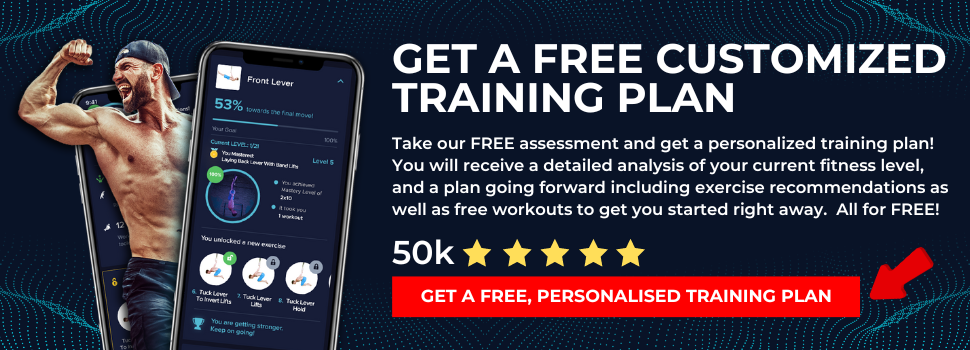For fitness enthusiasts who’ve been captivated by the art of bodyweight training, calisthenics is a godsend—a workout regimen that not only promises stellar physical conditioning but also demonstrates the incredible power of the human body. However, a prevailing myth in the calisthenics community is that it’s hard to build lower body strength and muscle mass without the use of weights. This guide turns that notion on its head by walking you through the ultimate manual for strengthening your legs and glutes solely with your body weight.
Why the Lower Body Matters in Calisthenics
When it comes to calisthenics or any functional training, the lower body is your powerhouse. Think of it as the center of gravity in motion. It’s not just about aesthetics; a strong lower body is fundamental to excelling in any physical activity or sport. From lifting weights to doing handstands, your legs play an integral role in almost every move; they are the foundation of strength and stability.
Principles of Training for Prosperity
In calisthenics, the principles of training align closely with those used in weight training but with a unique twist. Success is hinged on the following core tenets:
Progressive Overload
The gradual increase in stress placed upon the muscles promotes growth and strength, often achieved by changing the angle, increasing the range of motion (ROM), or manipulating leverage.
Effective Progressions
Movements are scaled effectively to ensure that you’re not stagnating or attempting exercises that are beyond your capability, which could lead to injury or poor form.
Constant Advancements
Always seek ways to make the exercises slightly harder as you progress—this could be via increased ROM, slowed tempo, or the addition of new variations.
Adaptive Approach
Listen to your body, and readiness should determine what you do. Not every day is a ‘max effort’ day, and that’s okay; flexibility is key to avoiding burnout.
Personalization
Your routine should reflect your goals and your body’s unique needs, strengths, and weaknesses.
Progressive Calisthenics for the Lower Body
Here, we’ll break down three levels of exercises for lower body strength using just your body weight.
Basic Exercises
Start with these fundamentals. As you can see Squat is a fundamental calisthenics exercise that you need to achieve to unlock all the other advanced leg variations
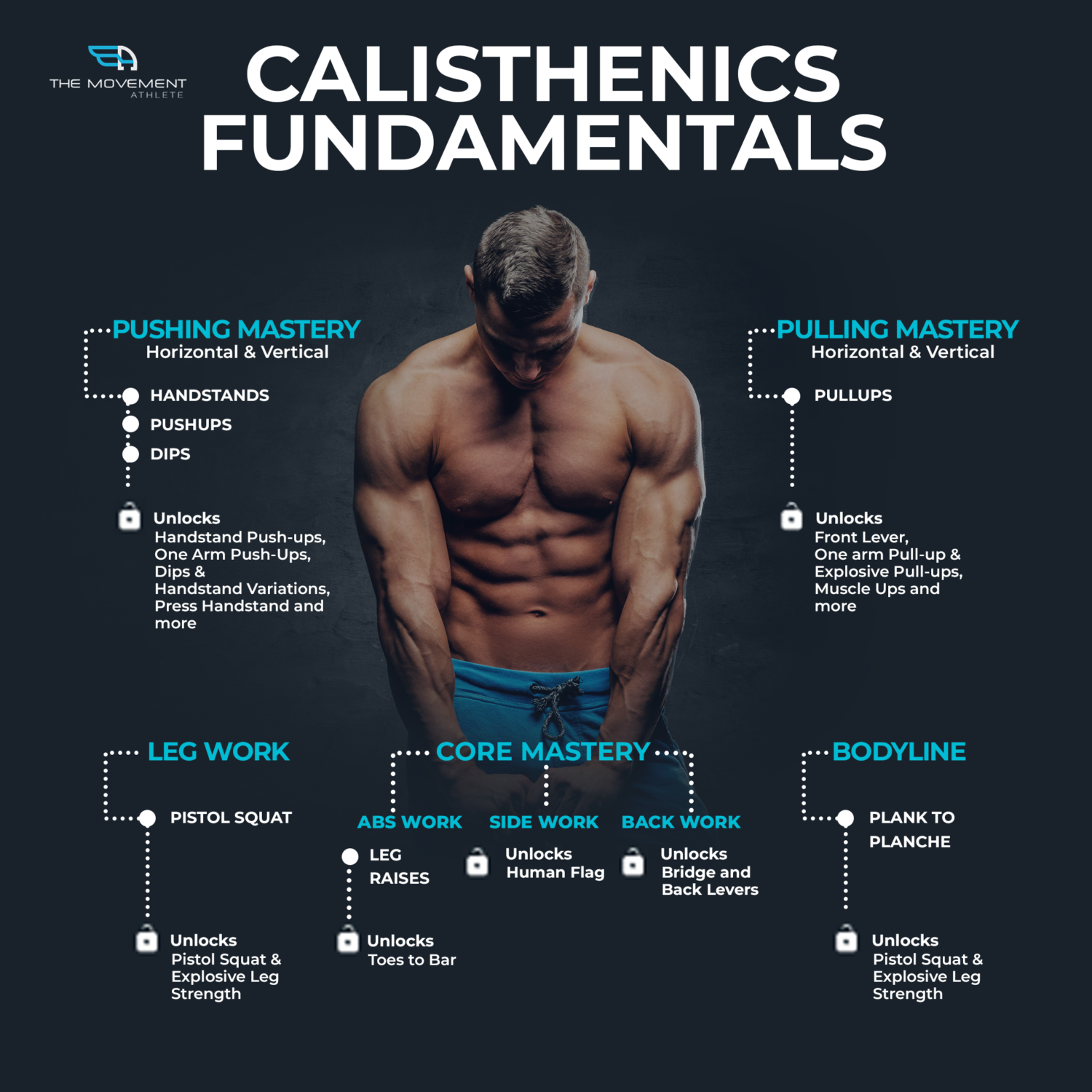
Calisthenics Fundamentals
You can see all calisthenics fundamentals in the app here:
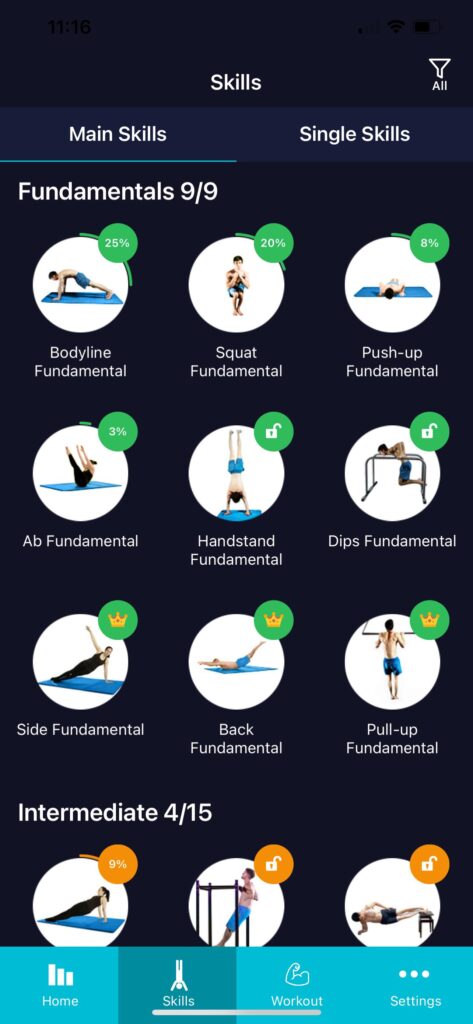
calisthenics fundamentals
Squats (Fundamental)
The bodyweight squat is a staple. It targets your quadriceps, hamstrings, and glutes. Here’s the breakdown:
- Stand with feet at shoulder width.
- Lower your body as far as you can.
- Ensure your back is straight.
- Hold for a second, then push back up to the starting position.
If you cannot do a squat yet, in our app you can take a calisthenics assessment that will show you exctaly what step of the squat progression you are at. But here is a basic squat fundamental progression plan
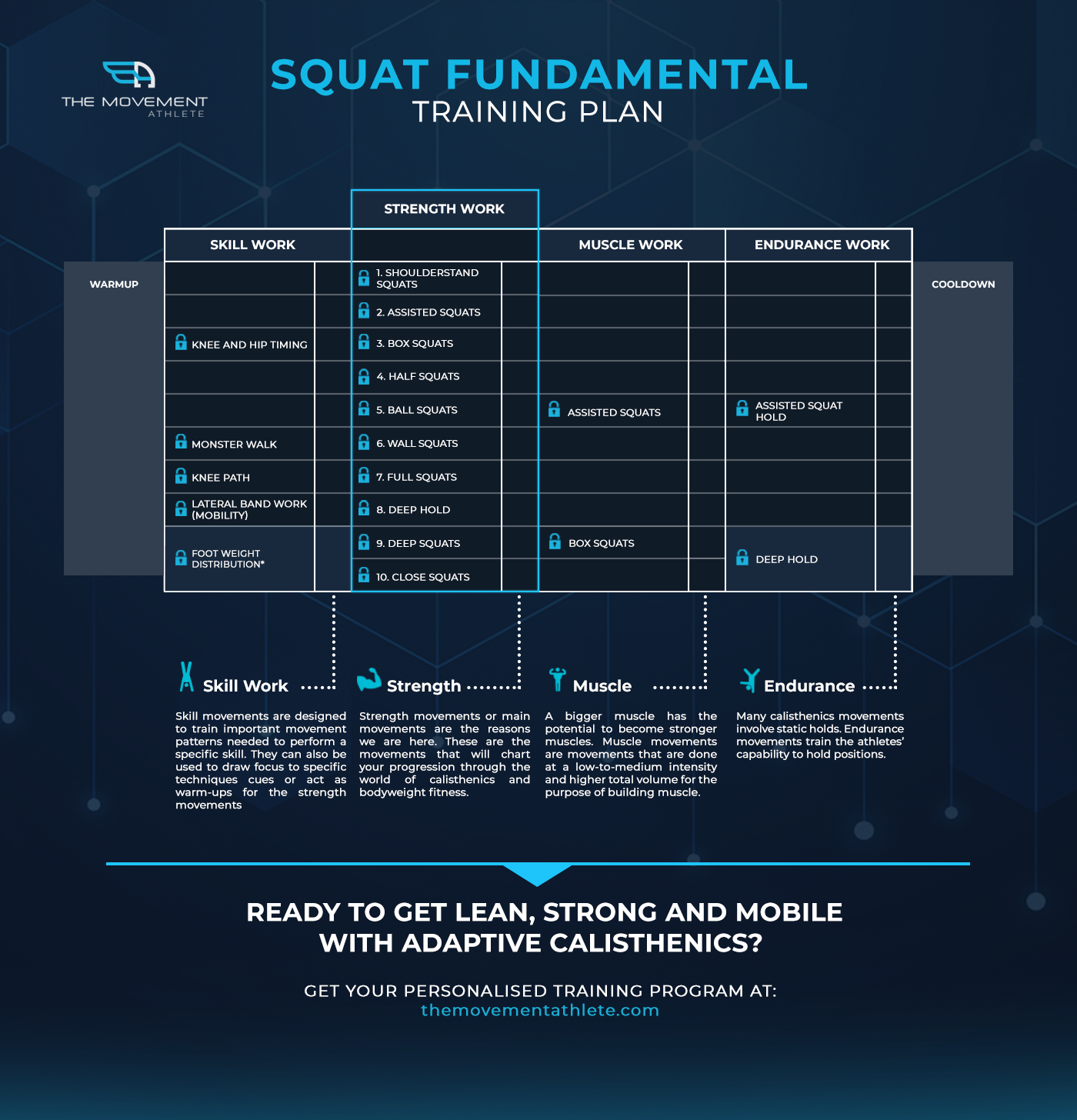
bodyweight Squat Training Plan
And here is how it looks inside the app

calisthenics squat progression
Lunges
Another simple but powerful exercise, lunges add an element of stability and balance:
- Stand with your feet shoulder width apart.
- Take a step forward with one leg and lower your body until your thigh is parallel to the ground.
- Push back up to the starting position and repeat with the other leg.
Intermediate Exercises
Once the fundamentals are in place, move to advanced calisthenics moves:
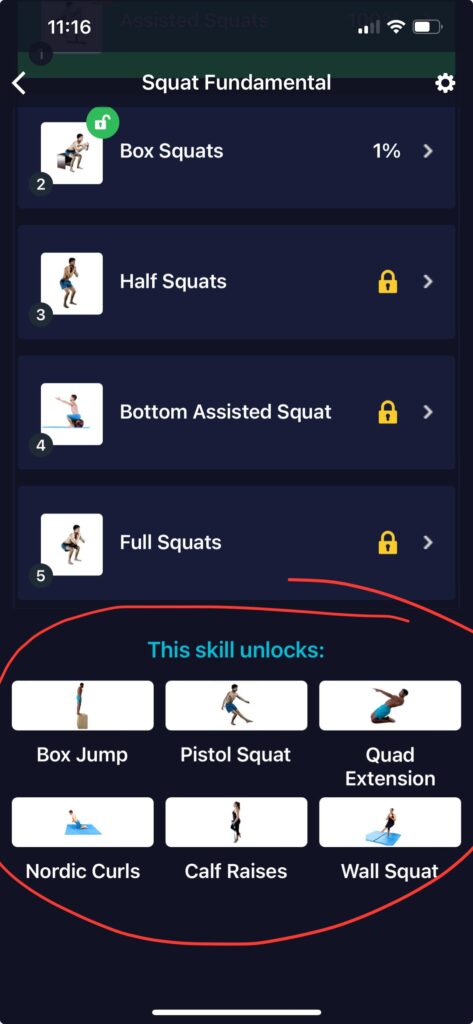
Advanced calisthenics leg exercises
Pistol Squats
The single-leg squat is a unilateral exercise that challenges both strength and balance:
- Stand on one leg, with the other leg extended in front.
- Slowly lower your body by bending your knee and hip, as if you were sitting back on a chair.
- Push back to the starting position.
Shrimp Squats
Similar to the pistol squat but involving different angles and muscle engagement:
- Bend one leg behind you, grabbing your foot with the hand on the same side.
- Squat down, keeping your back straight and chest up.
- Push back up to the starting position.
Advanced Calisthenics Leg Exercises
When you’re ready for maximum challenge, try these:
Pistol Squat
Once you can do a basic pistol squat with good form, add these elements for more difficulty:
- Holding a weight for counterbalance.
- Extending your arms forward or upward.
- Completing the movement on a raised platform for increased ROM.
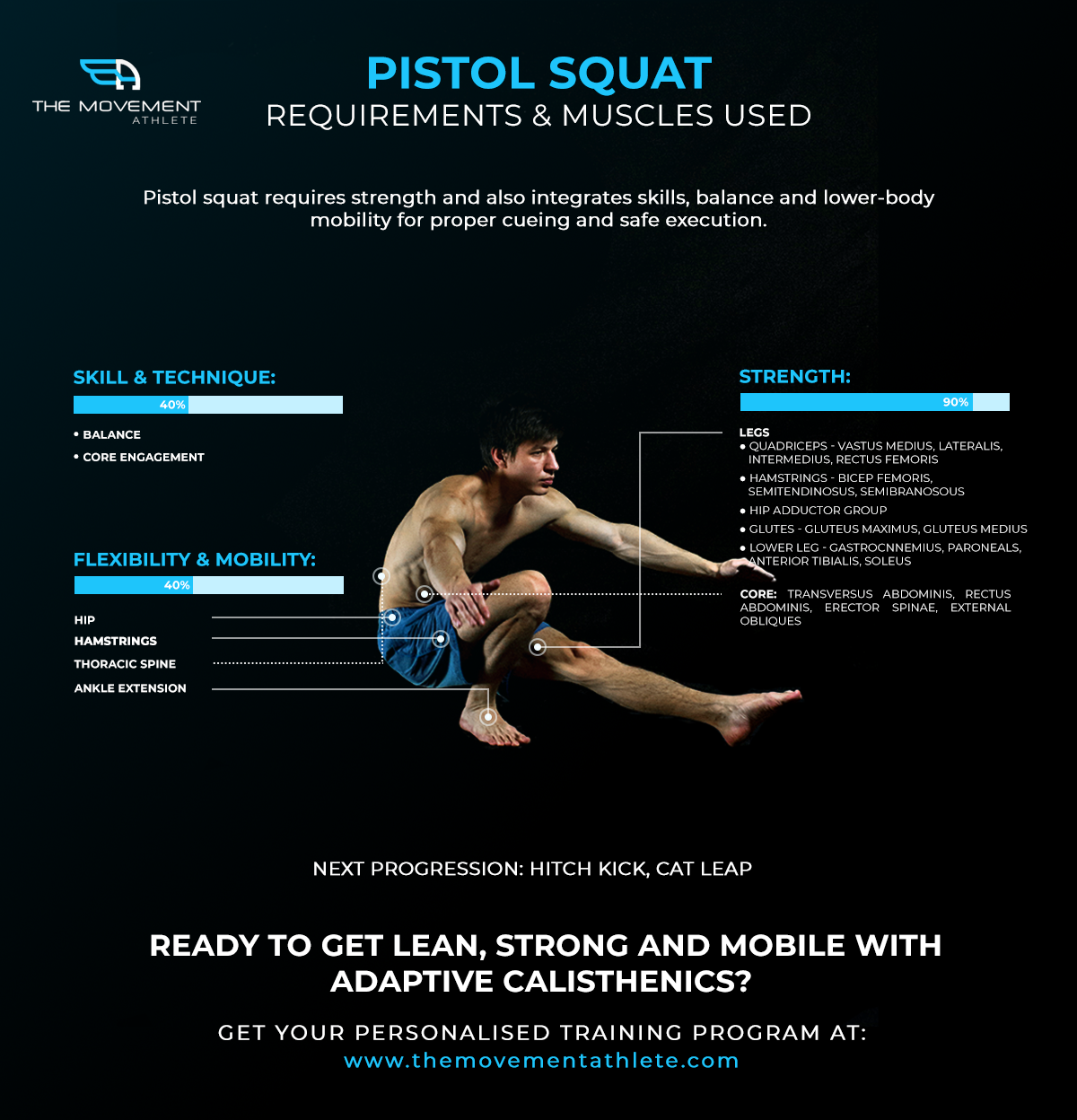
pistol squat how to
Sissy Squats
These are not for the faint-hearted, as they require a lot of flexibility and strength:
- Stand with feet hip-width apart and toes pointing directly forward.
- Lower your torso toward the ground, bending at the knees and ankles.
- Push back up to the starting position.
Remember, safety and proper alignment are paramount. If you’re not sure about a movement, consult with a fitness professional.
Nordic Curls
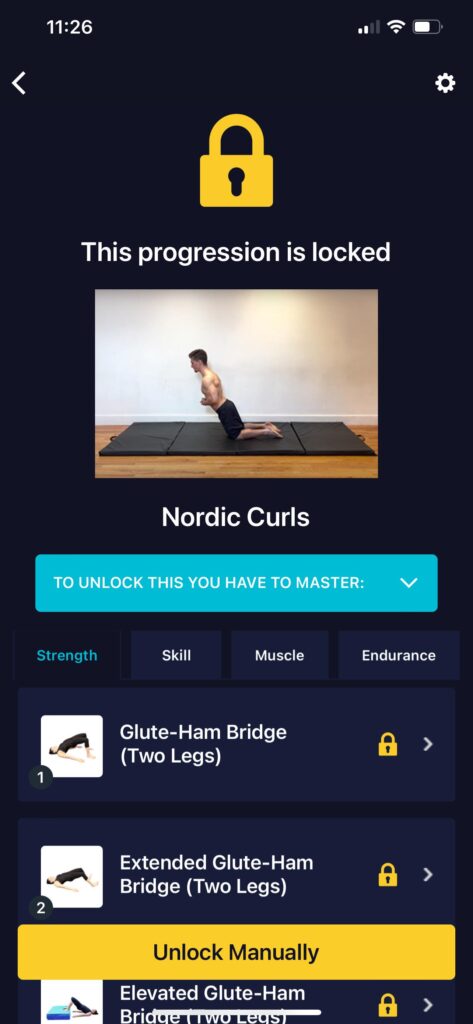
nordic curls advanced calisthenics leg exercises
Calf Raises

calf raises advanced calisthenics leg exercises
Box Jumps
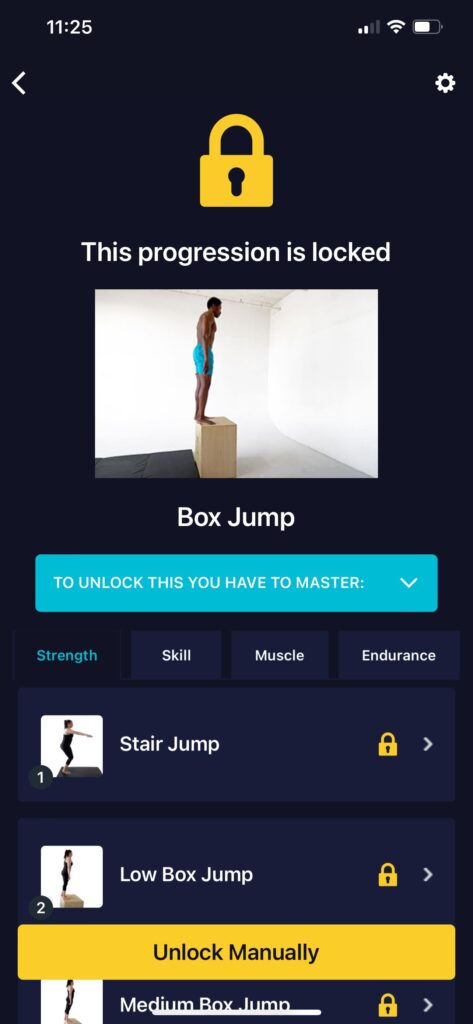
box jump advanced calisthenics leg exercises
Wall Squat

wall squat advanced calisthenics leg exercises
Quad Extensions

quad extensions advanced calisthenics leg exercises
Training Techniques and Tips
Proper technique is not just about looking good; it’s about preventing injury and ensuring that you’re actually hitting the intended muscles. Follow these tips:
Form Is King
Make sure your knees don’t go beyond your toes, your back stays straight, and your chest is up. Always maintain control throughout the entire ROM.
The Magic of Reps and Sets
For calisthenics, 3-4 sets of 8-12 reps for each exercise is a good standard. Adjust as needed based on your progress.
Adequate Rest
Allow at least 48 hours of rest for each muscle group before working it again. Muscles grow during rest, not during workouts.
Sample Lower Body Calisthenics Workout Routine
A structured and intentional approach is key to build a comprehensive and effective lower body routine with calisthenics. Below routine aims to provide a balanced approach to lower body training, maximizing results without the need for weights.
Before you dive in, we want to tell you that the best calisthenics leg training program is PERSONALISED
Why? Imagine you can’t do some of these exercises below or maybe some are too easy for you. This is why we created an assessment that in 2 minutes will give you a personalized training plan adjusted to your specific level. It will tell you exactly what level you are at and what skills you should be working towards. Each workout will be adjusted to your level and will dynamically adjust based on your feedback and your progress. This is how you get results with calisthenics.
Sample Lower Body Calisthenics Workout Routine
A well-structured calisthenics workout routine for the lower body encompasses a full warm-up, a meticulously planned main workout segment, and a cool-down phase to ensure safety and effectiveness. Here’s a detailed breakdown:
Warm-Up (10 minutes)
- Dynamic Stretches: 3 Minutes. Includes leg swings (front-to-back and side-to-side), hip circles, and ankle circles to prepare your joints.
- Bodyweight Squats: 2 Sets of 10 Reps. Focus on a full range of motion to activate your quadriceps, hamstrings, and glutes.
- Lunges: 2 Sets of 8 Reps per leg. Step forward into a lunge to engage your leg muscles and the core for balance.
Main Workout
The main part of the workout alternates between exercises focused on strength and those that enhance stability and endurance. Perform in a circuit to maximize muscle engagement and cardiovascular effort.
- Circuit 1: Repeat 3 Times
- Bodyweight Squats: 15 Reps. Ensure proper form to maximize safety and effectiveness.
- Lunges: 12 Reps per leg. Keep your upper body straight and core engaged.
- Rest: 30 Seconds between exercises, 1 Minute between circuits.
- Circuit 2: Repeat 3 Times
- Pistol Squats: 6 Reps per leg. Attempt only if you can maintain form; otherwise, continue with bodyweight squats.
- Shrimp Squats: 6 Reps per leg. Focus on balance and depth of the squat.
- Rest: 30 Seconds between exercises, 1 Minute between circuits.
Cool Down (10 minutes)
- Static Stretches: Hold each stretch for 30 seconds to 1 minute. Focus on the quadriceps, hamstrings, calves, and hips to aid in recovery and flexibility.
- Deep Breathing: 2 Minutes. Perform deep, controlled breathing while static stretching to help relax your muscles and return your heart rate to normal.
Remember, the main goal of this routine is to balance muscle strength, endurance, and flexibility. Adjust the reps, sets, and rest periods based on your current fitness level and goals. Always prioritize form over quantity to prevent injuries and achieve the best results.
Beginner Lower Body Calisthenics Workout Routine
Focus on mastering the basics and building a strong foundation with this beginner-friendly routine.
Warm-Up (10 minutes)
- Dynamic Stretches: 3 Minutes. Perform gentle leg and hip stretches to prepare your body.
- Bodyweight Half-Squats: 2 Sets of 10 Reps. Focus on not going too low but maintaining the correct form.
- Walking Lunges: 2 Sets of 8 Reps per leg. Use a shorter step than usual to maintain balance.
Main Workout
The main goal here is to familiarize yourself with the movements and focus on the technique.
- Circuit 1: Repeat 2 Times
- Bodyweight Squats: 12 Reps. Don’t go lower than parallel to ensure you keep good form.
- Step-back Lunges: 10 Reps per leg. A simpler variant that maintains balance and engages leg muscles.
- Rest: 45 Seconds between exercises.
Cool Down (10 minutes)
- Static Stretches: Hold each stretch for 30 seconds to 1 minute, focusing on the quadriceps, hamstrings, calves, and hips.
- Deep Breathing: 2 Minutes. Helps in recovery and relaxation of your muscles.
Intermediate Lower Body Calisthenics Workout Routine
Elevate the intensity and complexity of your workout with this intermediate routine designed for those who have a strong command of the basics.
Warm-Up (10 minutes)
- Dynamic Stretches: 3 Minutes. Incorporate more intense leg, hip, and ankle stretches.
- Full Bodyweight Squats: 2 Sets of 12 Reps. Ensure full range of motion.
- Dynamic Lunges: 2 Sets of 10 Reps per leg. Increase the step length compared to the beginner level.
Main Workout
This routine introduces more challenging variations and a higher volume of work.
- Circuit 1: Repeat 3 Times
- Bodyweight Squats: 15 Reps. Focus on depth and maintaining form.
- Lunges: 12 Reps per leg. Increase the depth and speed slightly.
- Side Lunges: 10 Reps per side. Introduces lateral movement for comprehensive leg training.
- Rest: 30 Seconds between exercises, 1 Minute between circuits.
Cool Down (10 minutes)
- Static Stretches: Quads, hamstrings, calves, hips, and glutes, holding each stretch for 30 seconds to 1 minute.
- Deep Breathing: 2 Minutes to relax your muscles and normalize heart rate.
Advanced Lower Body Calisthenics Workout Routine
At the advanced level, the focus shifts to mastering control, adding complexity, and challenging muscle endurance and strength further.
Warm-Up (10 minutes)
- Dynamic Stretches: 5 Minutes, including high-kicks and mobility drills.
- Bodyweight Squats: 3 Sets of 15 Reps, with emphasis on speed and depth.
- Lunges: 2 Sets of 12 Reps per leg, focusing on a longer stride.
Main Workout
Incorporates high difficulty exercises and variations for a comprehensive leg workout.
- Circuit 1: Repeat 4 Times
- Pistol Squats: 8 Reps per leg. Ensure solid balance and depth.
- Shrimp Squats: 8 Reps per leg. Challenges balance and targets different leg muscles.
- Jump Squats: 15 Reps. Adds explosiveness and power to the workout.
- Rest: 30 Seconds between exercises, 1 Minute between circuits.
Cool Down (10 minutes)
- Advanced Static Stretches: Focus on deeper stretches for the quadriceps, hamstrings, calves, and especially the hip flexors.
- Meditative Breathing: 3 Minutes to deeply relax your muscles and body, fully recovering from the intense workout.
Nutrition and Recovery
Muscles need fuel to recover and grow, so eating right is crucial.
A balanced diet rich in protein, carbohydrates, and healthy fats plays a vital role in muscle recovery and growth. Protein, the building block of muscle, should be a staple in every meal and snack to support the repair of muscle fibers broken down during training. Carbohydrates fuel your workouts and are essential for replenishing glycogen stores, while healthy fats are crucial for hormonal balance and joint health. Additionally, staying hydrated is key; water supports every metabolic function and nutrient transfer in the body and is critical for optimal performance and recovery. Don’t overlook micronutrients—vitamins and minerals like magnesium, zinc, and B vitamins are essential for energy production and muscle contraction. A well-rounded diet, combined with proper training, sets the foundation for strength gains and muscle growth in lower body calisthenics.
Rest Like a Pro
Quality sleep and active recovery days are just as important as the workouts themselves.
Supercharge Your Recovery Game
Alright, folks, you’ve got the sweat sessions down, but how about we turn you into a recovery ninja? First off, throw the “no pain, no gain” mentality out the window. Pain’s not an RSVP to the gains party. Listen to your body. If it’s screaming at you, maybe screaming back (with rest and recovery, not actual screaming) is a good idea.
Hydration Station
You know water’s your BFF during workouts, but it’s also the hero in your recovery saga. Imagine your muscles throwing a ‘thank you’ party because you kept them hydrated. Drink up before, during, and after workouts. No, beer doesn’t count. Sorry!
Flexibility is Key – Literally
If you’re as flexible as a steel rod, it’s time for a change. Incorporate yoga or basic stretching exercises into your routine. Not only does it help with your mobility, but it also reduces soreness. Plus, you’ll look cool being able to touch your toes or pull off a pretzel pose.
Active Recovery
Consider active recovery your secret weapon. Think light jogging, swimming, or even a casual bike ride. It’s about moving enough to get the blood flowing without taxing your body. It’s like telling your muscles, “Hey, take it easy but stay awake.”
Eat Like a Champ
And no, we don’t mean eating the weight of a small child in pasta. Your body’s a temple, right? Well, time to stop throwing in just anything as an offering. Balanced meals are your foundation. Lean proteins, complex carbs, and don’t forget those leafy greens! Your muscles eat that stuff up for breakfast (and so should you).
Sleep – The Ultimate Healer
Don’t skimp on zzz’s. Your body does its best recovery work while you’re dreaming about bench pressing clouds or whatever it is that you dream about. Aim for 7-9 hours. Trust us, Netflix will survive without you for one night.
Remember, muscles are built in the kitchen and repaired in bed. Or something like that. Keep these tips in your back pocket, and you’ll be flexing recovery muscles you didn’t even know you had. Stay loose, stay hydrated, and maybe try going to bed before midnight. Just saying.
Want to get real results for your lower body with calisthenics? Get a personalized training plan.
Enter Personalization
Tired of the “one-size-fits-all” workout grind? Here at The Movement Athlete, we get that your fitness journey is as unique as your playlist. That’s why we kick those cookie-cutter routines to the curb and serve up personalized training that’s as unique as you are.
Tailored Training for Real Results
Whether you’re a newbie or near superhero level in fitness, personalized training crafts workouts that fit you like a glove. It’s all about where you’re at now, where you want to go, and making sure the ride there is packed with achievements. We balance challenge with capability, so every sweat sesh is just right.
Safety and Enjoyment
Diving into workouts that match your groove means saying buh-bye to injury risks and hello to a whole lot of fun. With personalized training, every leap forward is a high-five moment, keeping the motivation engine revving and the smiles coming.
Take the Free Assessment with The Movement Athlete
Ready to chuck the bland workouts and flex your uniqueness? The Movement Athlete is here with a high-five and a FREE assessment. Jump in to find a training plan that’s all you – fitting your fitness level and goals like a well-worn pair of sneakers.
Personalized training isn’t a trend; it’s how you turn up the volume on effectiveness, enjoyment, and safety. Wave goodbye to the generic and hi-five your way to workouts that understand you’re one-of-a-kind. Start building those biceps and a bulletproof body with your name on it today with The Movement Athlete.
Find out more about Calisthenics Exercises for legs

